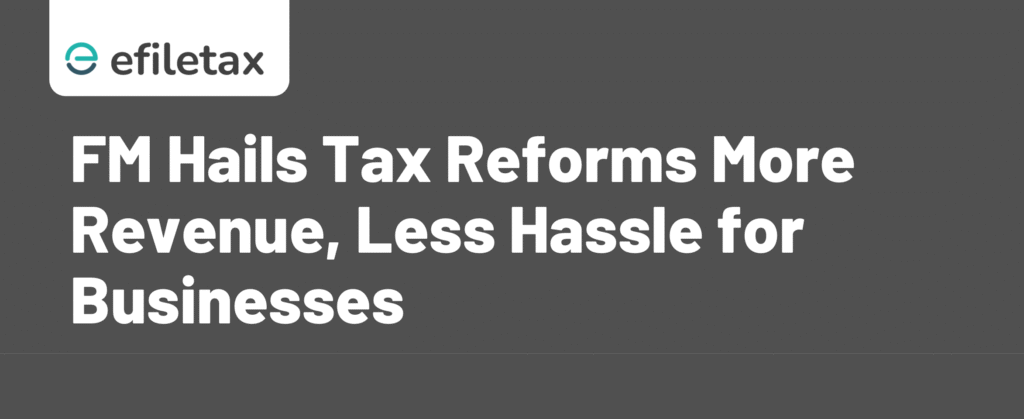
India’s Tax Reforms and Digital Push: What FM Sitharaman’s Statement Means for You
In a recent public address, Finance Minister Nirmala Sitharaman said India’s tax reforms and digital push have increased revenue and reduced compliance costs for businesses and taxpayers. But what exactly are these reforms? How have they helped the average Indian taxpayer or small business?
Let’s break it down in simple terms.
Keyphrase Subheading: India’s tax reforms and digital push – A quick overview
India’s tax system has undergone a major transformation in the past decade. The goal?
Increase transparency, widen the tax base, and reduce human interference.
Here’s what has changed:
Direct Tax Reforms
- Faceless I-T assessments: Eliminated in-person visits to tax officers
- New tax regime under Section 115BAC: Lower rates, fewer exemptions
- Pre-filled ITR forms: Auto-import of salary, interest, and capital gains data
- e-Verification and e-PAN services: Instant and paperless
Indirect Tax Reforms
- GST rollout (since 2017): One nation, one tax
- GSTN portal upgrades: Faster refunds, real-time invoice matching
- e-Invoicing, e-Way Bill system: Automated tracking and reduced tax evasion
- QRMP scheme: Quarterly returns for small taxpayers with monthly payments
The Impact: Revenue Up, Costs Down
As per Union Budget 2024 and CBDT-CGST data:
| Parameter | Before Reforms | FY 2023-24 (Post-Reform) |
|---|---|---|
| Gross Direct Tax Collection | ₹8.49 lakh cr | ₹19.58 lakh cr |
| GST Collection (Annual) | ₹8.1 lakh cr | ₹20.18 lakh cr |
| ITR Filing (Individuals) | 5.5 crore | 8.18 crore |
| Avg Refund Time | 2-3 months | 7–14 days |
👉 Source: www.incometax.gov.in, www.gst.gov.in
Legal Backbone of Reforms
These changes are backed by laws and official notifications:
- Section 139(1): Mandatory e-filing for certain categories
- Section 148A: Digital re-assessment notices
- CGST Rules 2024 amendments: Real-time compliance via e-invoicing
- CBDT Circular No. 6/2025: Return due date extended due to system upgrades
Expert View: Why It Matters to You
“With automation and faceless systems, harassment and delays have come down. MSMEs now spend less on compliance consultants. It’s a game-changer,”
— CA Ramesh Kumar, Partner at TaxSolve LLP
Takeaway: Lower chances of scrutiny + faster refunds = better cash flow for individuals and small businesses.
How It Helps You – Real Use Cases
- Salaried Individuals: Get pre-filled ITRs with bank & salary details
- Freelancers: Easy GST registration and invoice generation via GSPs
- Small Business Owners: File quarterly returns via QRMP and use e-Invoice tools
- Startups: Claim refunds faster and avoid penalties through auto alerts
Step-by-Step: How to Maximise Benefits
- Use EVC or Aadhaar OTP for ITR verification – No need for physical documents
- Log in to Income Tax Portal – View Form 26AS, AIS, and TIS reports
- Use e-Invoice for B2B deals – Mandatory if turnover > ₹5 crore
- Choose right tax regime – Compare 115BAC vs Old Regime in ITR form
- Register with a GSP like Efiletax – For bulk GST, ITR, and ROC filings
FAQ – India’s Tax Reforms and Digital Push
Q1. Are faceless assessments applicable to all taxpayers?
Yes, for scrutiny cases, faceless is the default except in special circumstances like searches or sensitive cases.
Q2. Do I still need to visit a tax officer for refund queries?
No. All queries are handled via email or portal now. Personal visits are discouraged.
Q3. Is e-Invoicing mandatory for all businesses?
Only if annual turnover exceeds ₹5 crore (as of FY 2024–25), but the limit may reduce in future.
Summary
India’s tax reforms and digital push have simplified compliance, increased tax revenues, and reduced costs for individuals and businesses. With pre-filled ITRs, faceless assessments, and GST automation, the system is faster, fairer, and more transparent.
🔗 Related Blog
👉 Can You Switch Tax Regimes While Filing ITR? Explained
Final Word + CTA
India’s move towards a transparent, tech-driven tax ecosystem is working. Whether you’re an individual or a small business, these reforms mean less paperwork, faster refunds, and reduced scrutiny.